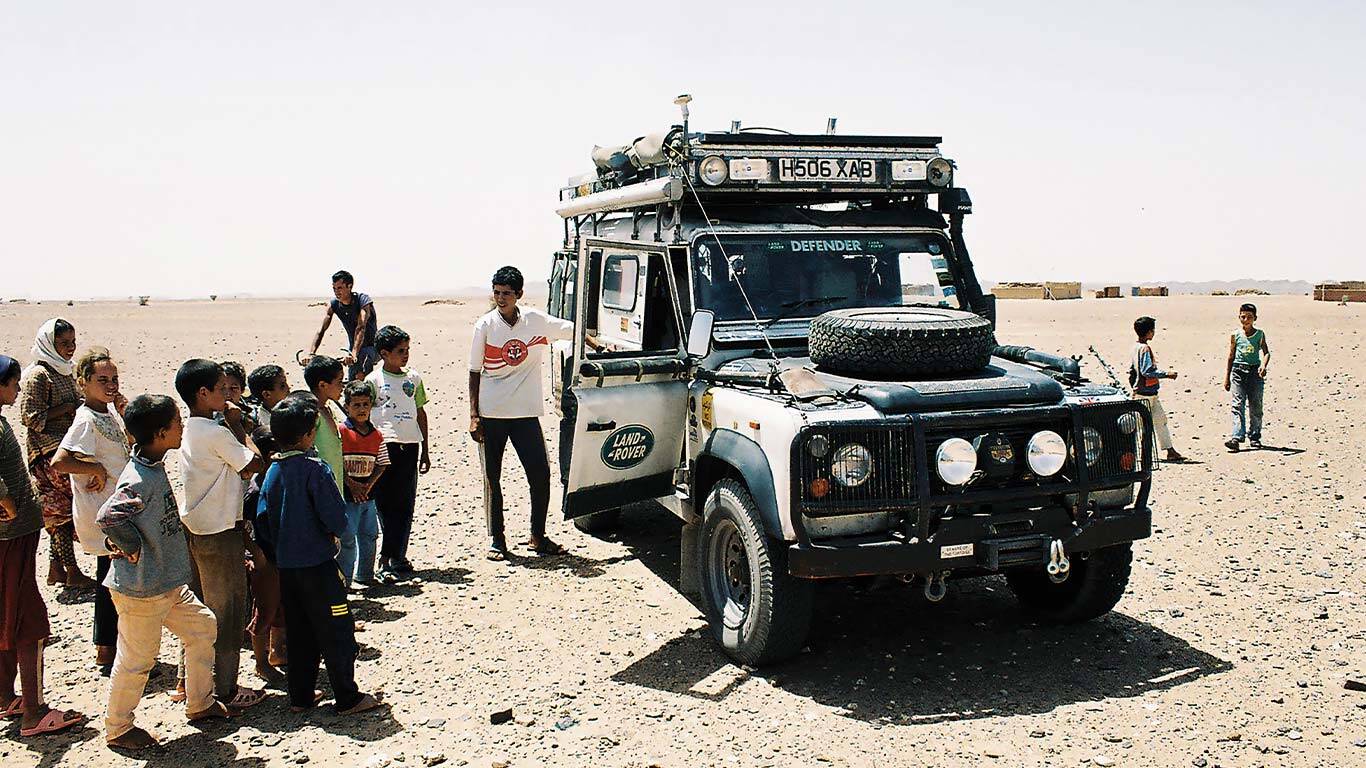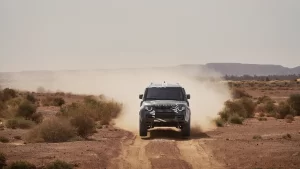It’s a situation many vehicle-dependent travellers face—when your vehicle has covered tens of thousands of reliable kilometres and carried you to places of which you have long dreamed, inevitably it gets old, and worn. Your sensible streak says: time to replace it. It’s a thing of metal and wires, and critical systems are becoming too old to expect reliability in remote areas. Your emotional side says: no, this is an old friend, the result of the investing of many hours of plans, money and imagination. The partner that has shared adventures, risks and laughter with you. If, like me, you give the vehicle a name, your doom is sealed.
This was the situation I found myself in, as the owner of a 30-year-old Land Rover Defender 110 with 650,000 km reliable travel behind her—all around Europe, parts of Africa and the eastern Mediterranean, and during multiple Sahara trips, usually as a solo vehicle. The Land Rover, named “Elsa” (after the lioness in the movie Born Free) had started life as a British Army “winterised” 110, and had seen combat in Kosovo and the Balkans with the Royal Marines Commando Helicopter Force, as well as numerous deployments around the world from aircraft carriers of the Royal Navy.
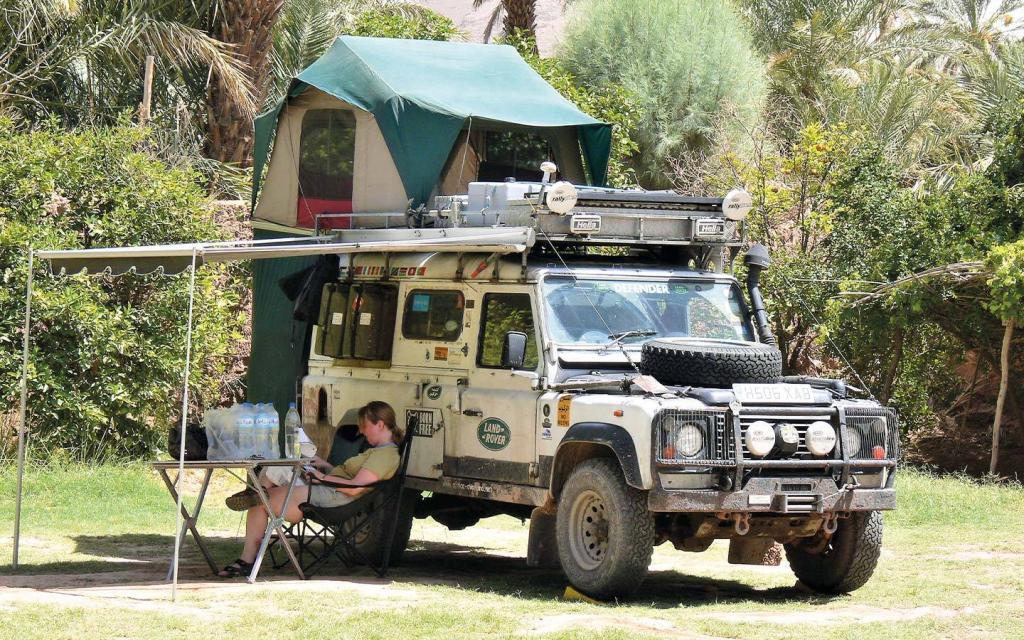
Released from service in 2000, with a mere 20,000 km on the clock, the truck was a military utility vehicle with the addition of engine, battery and cabin arctic-spec Webasto heaters—large copper radiators fed by a separate diesel burner in the engine compartment. It was the perfect basis for an overland truck: a hardtop, minimal (no) electronics, twin battery system, and a simple, reliable diesel engine. Having bought her in the April of 2000, I had her sprayed white, fitted a winch and drove her to Morocco and Algeria in June—but forgot to find a way to turn the arctic heaters off. The heat of the Saharan summer received “military assistance” in the vehicle, and as soon as I found the pipes feeding the radiators I quickly installed a bypass!
The trip was a great success, however, and paved the way for regular Saharan journeys as well as long-term crisscrossing of Europe and chunks of Africa. The years and the kilometres then mounted up. Dreams, ambitions, memories were all amassed thanks to this simple, basic and superbly fit-for-purpose vehicle.
Fast forward to 2018, and driving through a snow blizzard in the Scottish mountains late at night, I realised the cab heater had stopped working. With a windchill factor of around -30°C, a water pipe then froze in the windscreen washer spray, and the cab filled with froth and bubbles from the dashboard as the water chose a different route of escape. Some of the water entered behind the dashboard instruments under pressure and shorted out the dashboard lights. After 27 years of military service followed by regular overland travel, she was starting to show her age.
Days later on my return to home base in Northern England, I realised that her 200Tdi engine was sounding more rattly and agricultural than usual. So I took her to Ben Stowe, the guy who looks after her, and who runs Black Paw 4×4 in York. Ben’s name might be familiar to some, as he was responsible for the rebuild of Oxford, the Series One Land Rover of First Overland fame—as well as countless other overland and expedition vehicles—not to mention being a veteran of several Saharan trips himself.
PLANNING
Ben had the tough old beast in for a check-over and announced his findings. Components were showing their age and length of hard service. Over 600,000 km, much of them in desert conditions of great heat and abrasion from sand, had made their presence felt. He and I settled down with that well-known non-vehicle specific lubricant, beer, and talked through the issues. Elsa wasn’t old and finished just yet, but even a truck as solid as this one would start to deteriorate before long. The engine needed a rebuild. The various ancillary systems were starting to wear. Pipes were getting thin and corroded. Was it time to replace her before the next big trip? Retire her and keep her as a weekend camper? Sell her? The conversation went on a while, as you can imagine.
I was unwilling to change marques. I had no reason to—having driven Land Rovers and most types of Japanese and American 4×4 on various long trips in arduous conditions around the world, I’d always found the ability and reliability of Land Rovers (especially Elsa) surpassed any competitors. I didn’t want a Td5 or a TDCi engine as I wasn’t keen on the electronics and the increasing lack of tolerance for poor-quality fuel in modern engines. Yet, several times I’d found Elsa’s configuration of two seats and a large load bay a bit limiting; if I wanted to carry family, friends or passengers then generally the single passenger seat soon filled up, and that left the long bench seats in the rear—not ideal.
On the other hand, that big load area was perfect for sleeping in, should I need to pass on her MyWay roof tent and sleep inside the car for reasons of bad weather or stealth.
It was Ben that came up with the final idea—why not stretch her to a 130? Silence fell whilst this rather mad idea fermented. I could see that…first and second row seats from a crew cab, and could we somehow bolt on the whole rear load bed from the 110? Essentially keep the 110 format, with an extra row of passenger seats?
Okay, yes, how do we do this?
I’d spent a lot of time in Kenya and Tanzania in the mid-2000s in a Defender called Maggie, a hardtop 110 which we think has completed more UK-Cape Town drives (or vice versa) than any other vehicle. At the time of writing, she’s still going in Mozambique and undergoing preparations for yet another drive back to the UK. Maggie initially left the UK as a Defender 90, but I opted to rebuild her as a 110 following a road accident in Kenya.
UK law does not, however, allow us to simply cut the chassis and weld in another 20 inches of steel, as we did with Maggie. We needed another solution. A donor vehicle—a Defender 130 which we could lift the bodywork from, take the chassis, and bolt Elsa’s bodywork, engine, transmission and safari gear straight onto. If we planned it right we might even be able to build some sort of 110 out of the bits left over.
It was by chance that another friend had a matching pair of ex-Southern Scotland Electricity Board Defender 130s: crew cab 300Tdis with box bodies on the rear (one of which he’d lent me some years before)—and he was keen to sell one of them. Perfect. Money changed hands. I was living in the United Arab Emirates at the time (as I am now), and so buying and moving the 130 around the UK took some prior planning; but one snowy December evening we finally lined up both the 110 and the 130 at Black Paw for the great transformation.
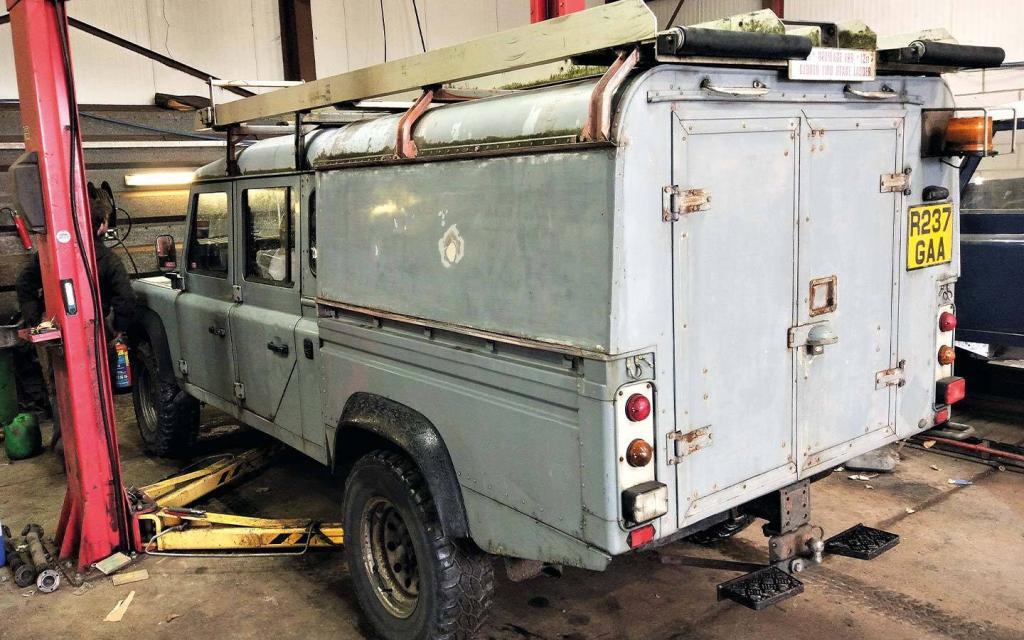
ENGINE & BODYWORK
The first job was to take all the body panels off the two vehicles and take stock of engines, transmissions and chassis. The 200Tdi engine and LT77 drivetrain of the 110 were worn, as expected, but still perfectly functional. The 300Tdi and R380 from the 130 were in a much better state, with about a quarter of the mileage of the older Land Rover, so it made all the sense in the world to keep them in place for the bodywork swap, with a few minor tweaks.
Emphasis for the 130 was to be on fuel economy and reduced engine temperatures for desert drives. So the old radiator came out, and replaced by a triple-layer tropical spec unit from Northern Radiators in Leeds. I debated an aluminium radiator core for even greater cooling efficiency, but opted for copper in the end as it’s tougher for arduous use. The old intercooler was replaced by the thickest one I could get from tried-and-trusted supplier Allisport (the 200Tdi in the 110 has an Allisport intercooler that’s about fifteen years old, and still solid) and fitted to the 300Tdi, augmented by a hybrid turbo from Fourby in Birmingham.
I also fitted a Morgan Hill boost pin, again in an attempt to increase efficiency rather than raise horsepower. I deliberately avoided modifications that would increase engine temperatures solely to gain power. An Exhaust Gas Temperature gauge monitors the turbo temperature when grinding through soft sand in Saharan dunes. We blanked off the EGR valve and the central silencer box on the 130 exhaust removed – a simple but effective modification to increase torque.
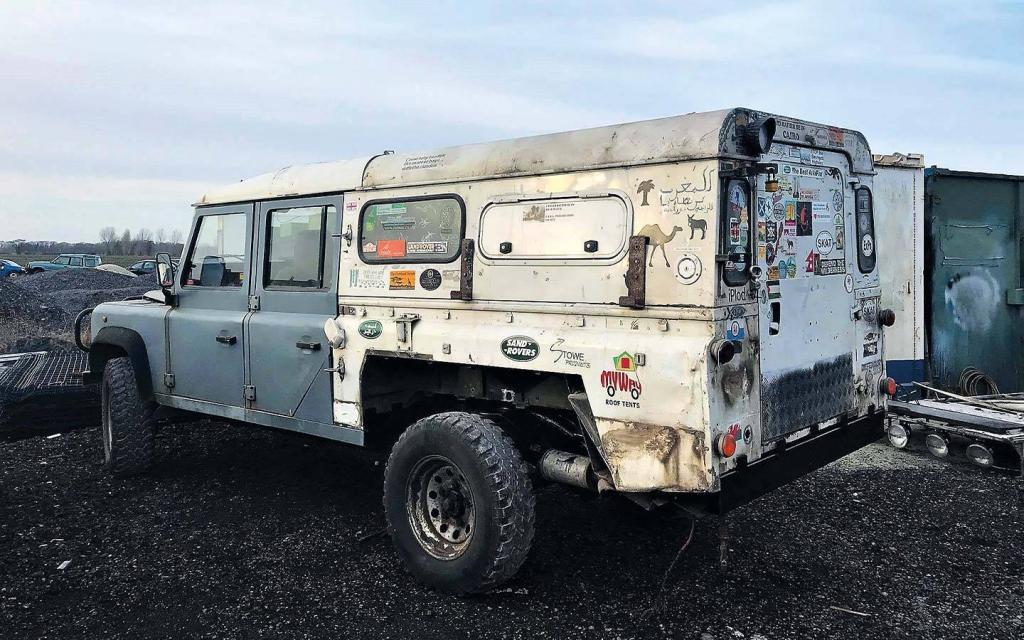
We dry-fitted the bodywork from the 110 onto the 130, keeping in place the second row of passenger doors. Everything fitted, and what was doubly nice was that the rear body from the 110 sat neatly on the back half of the 130 chassis with a combined length of almost exactly that of the original 130 crew cab. There were a couple of issues: a new, longer, roof needed fabricating and the wheel arch on the rear body (from the 110) was in the wrong place for the 130 axle—deftly solved by Ben with an invisible “cut and paste”—and the rear crossmember was in the wrong place.
I specified the addition of a custom swing-away rear spare wheel carrier that could also carry two full fuel jerrycans, and this needed a full 110-style rear crossmember, which the standard 130 design lacks (the actual crossmember is recessed under the rear body on a 130). So, Ben had to fabricate an extra length of chassis and a second rear crossmember to weld on, to enable this feature.
As the 130 took shape, it became apparent that the leftover parts would form a decent vehicle in their own right, so a parallel project evolved—a 110 200Tdi pickup which used a spare 110 pickup bed that Ben had lying around. My plan was to use this as a weekend camper for UK and West European trips, and to mount a safari trailer-tent sized roof tent above a rear body equipped with lockers—but that’s another story!
SUSPENSION
The suspension of the 130 was the next project item. We realised that the extra length of the vehicle over a standard 110, plus the addition of the extra weight of a large spare tyre, steel wheel and two full jerrycans right at the tail of the long Land Rover, would cause much more work for the suspension.
As a 110, Elsa had run Camel Trophy-spec coil-within-coil springs and De Carbon shockers (this had replaced a setup with heavy-duty springs augmented by airbags—fine until one airbag had become abraded with Saharan sand in the Merzouga dune sea in Morocco, and burst, leaving one side of the vehicle 10 cm taller than the other…until surgery with a penknife in a sandstorm levelled things again). We felt that this was fine for a 110, but the 130 needed something beefier. We kept the Camel spec coil-in-coil springs, but fitted double Fox remote-reservoir shocks on each side of the chassis and also a bigger anti-roll bar to cope with the twisting and swaying inevitable in rough country.
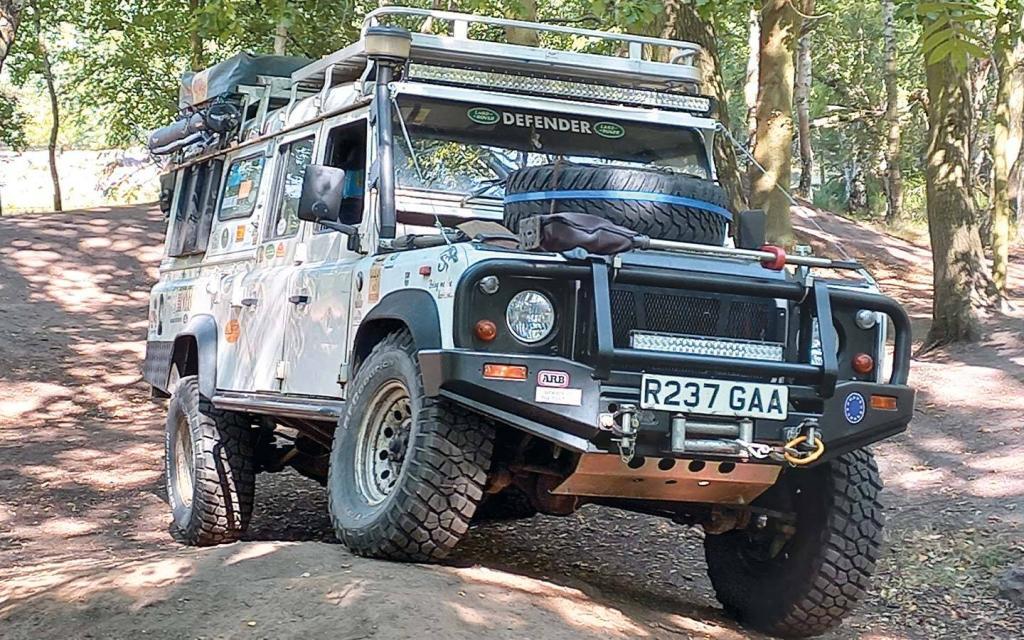
The rest of the bodywork went onto the 130 without issue, though the raised air intake needed swapping from the left (UK passenger) side, normal for a 200Tdi, to the right (UK driver) side for the 300Tdi. At the same time, Ben fabricated a stainless steel tube for the raised intake with a large cyclonic Donaldson pre-cleaner on top, linked to a full set of breathers for axles, gearbox and transfer case, and so on—again from Fourby.
SAFETY & RECOVERY
The ability to self-recover was a big deal. This was going to be a big, heavy vehicle, and tough to extract from soft sand or mud, should she get stuck. Elsa had a Superwinch 9000+ in place already but this was showing its age, as was her bull bar. Both were replaced—the bull bar with an ARB item and the winch with a Warn XD9000. The winch ideally needed to have a larger capacity to deal with the big vehicle, but the 9000 was what we had to hand, and it will be replaced later. The new ARB bull bar was surprisingly flimsy and thin, and needed reinforcing plates welded inside it to enable the option of using it as a Hi-Lift jacking point, or towing and recovery point.
We also added a pair of Camel Trophy Dixon-Bate recovery jaws to the unit. I had a set of jackable side sills fabricated (with appropriate extra chassis outriggers) to enable Hi-Lift recovery from the vehicle sides. The Warn winch, annoyingly, was tough to fit; in fact, we had to mount it on its side, and cut away some of the bodywork, to locate it correctly (despite the ARB bull bar being apparently designed for Warn winches)—but it went in eventually. I kept the standard wire rope on the winch rather than change to any synthetic winch cable, as wire rope suffers much less damage from sand grains and the intense ultraviolet of desert sun. Tyres are key to self-recovery and we fitted older-pattern Goodrich 285 Mud Terrains on steel rims—older pattern as they are more grippy!
Ben and I were always mindful of vehicle stability in the project. A laden Defender 110 travelling at 100 km/h is capable of exerting and undergoing some terrifying forces when moving, both controlled or uncontrolled, and we were making a big, heavy vehicle bigger and heavier, so these forces would get even bigger and more potentially destructive. The braking system was fine (she was already on vented discs) but we next turned our minds to the centre of gravity.
I had specified the custom rear spare wheel carrier as on long-distance remote area trips I prefer two spare tyres, and I also wanted to carry two jerrycans on the back (thanks to a blacksmith near the Pyramids in Cairo, she already has a twin jerrycan rack on one side of the body). One spare wheel goes on the bonnet, and I refuse to consider mounting one on the roof rack as it raises the centre of gravity uncomfortably high and the dynamic roof load rating on a Defender is surprisingly low.
So, to keep the centre of gravity as low as possible we had to build the rear wheel carrier, as already mentioned. There was also an imperative to keep the centre of gravity front-to-rear between the two axles, so the truck wouldn’t want to “wag her tail” too much—a challenge with the now much longer tail. As a 110, Elsa’s rear load area was fitted with two stacked Front Runner sliding storage units for Wolf Cub boxes, and these are very handy—more useful than storage drawers, as I can remove whole boxes of gear (for example kitchen gear or camp kit) and carry them to wherever I camp or they are needed.
However, they are still heavy (and overlap and hang beyond the back axle); so one layer came out and migrated to the 110. Two drinking water tanks were relocated, moving further towards the centre of the vehicle; and other heavy gear like the Hi-Lift jack, fridge, spare parts locker and recovery gear was similarly moved between the axles.
ROOFTOP
Things were coming together well. I debated a full-length 130 roof rack, but instead (in the interests of cost and weight) mounted two Front Runner roof bars at the rear to accommodate the lightweight MyWay roof tent Elsa has always worn (I prefer a softshell tent to make the most of roof space, and a tent that opens over the rear door to provide shelter for cooking and a shower space). Forward of the roof bars went another pair of roof bars to take an aluminium box which contains bedding and clothing (accessible from the tent), and in front of that went a Front Runner roof rack of a size that normally fits full-length on a Defender 90.
ELECTRICS
Vehicle electrics came next. Elsa had had a twin battery installation for years, but we decided to up this to Camel Trophy spec by wiring the two underseat batteries together in parallel as a single starter “battery” to double the current for starting in arduous conditions, and then fit a third battery, a deep-cycle, to deal with the fridge and other auxiliary tasks.
All of this is now overseen by a National Luna monitoring system. There’s also the capacity to connect an 80W solar panel into the system for use when the vehicle is stationary for a while. It’s a fact that by deliberate intent there are few electronics on board, but there are two GPS systems, a Garmin 276c and a Garmin Montana (I had an early Garmin fail on me on the edge of an Algerian minefield once—so now I travel with two systems). These are both hardwired into the vehicle; although in the event of a stranding they can be removed and run on AA batteries.
The only other significant electrical equipment (apart from the Engel fridge and some extra USB and marine 12V sockets dotted around) is a hardwired Viair compressor set inside the front wing, behind the headlamp and accessed by a locker door in the wing top. This enables me to air down tyres for soft sand driving and quickly re-inflate them afterwards.
COMPLETION
We were nearing completion. As a 110, Elsa had been fitted with a gullwing door bought as an external locker door from a motorhome shop (considerably cheaper, by a factor of ten, than buying a fancy version designed for a Defender); but now her rear body was much bigger, so I wanted a larger one. Turkish overland equipment specialists Rhino Overland took great delight in custom-building an enormous gullwing door that spanned almost the whole length of the 110 rear tub, and this was very straightforward to fit (although, until the lockers were fitted behind it, Elsa did rather look like a roadside burger van).
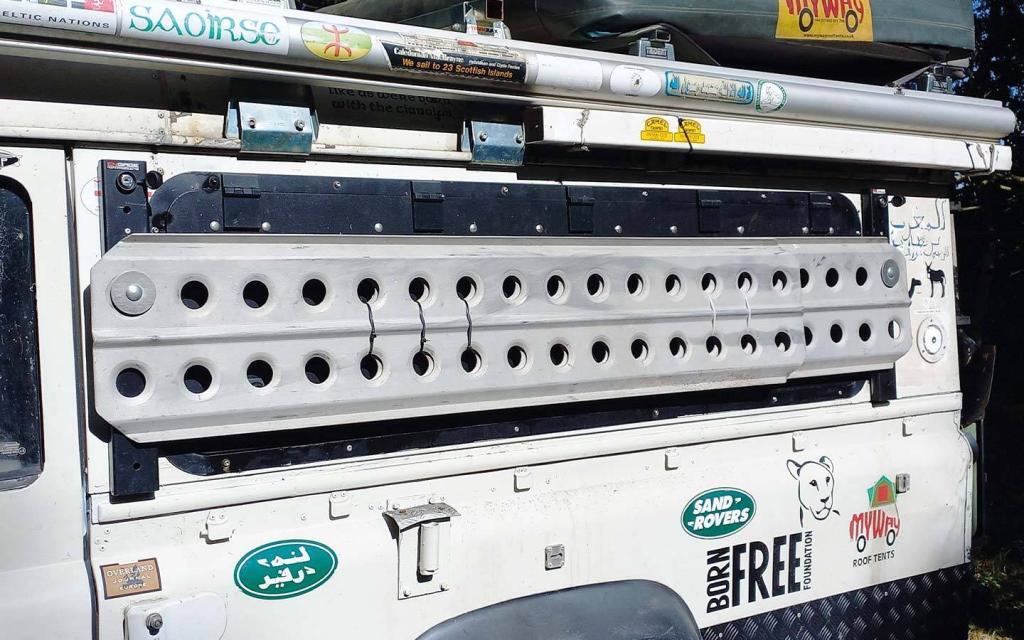

Small details were added—fold-flat transom steps from yacht chandlers gave unobtrusive roof access. Military-spec Spafax “indestructible” wing mirrors replaced standard units. Bush wires protected the windscreen from errant branches and undergrowth. A visor added over the windshield protected against glare when driving into the setting sun. Exmoor Trim canvas seat covers protected the vinyl seats and gave handy pockets for things like a fire extinguisher. Assorted pouches and pockets by Camp Cover were fitted around the vehicle for quick and easy stowage of the necessaries of camp life.
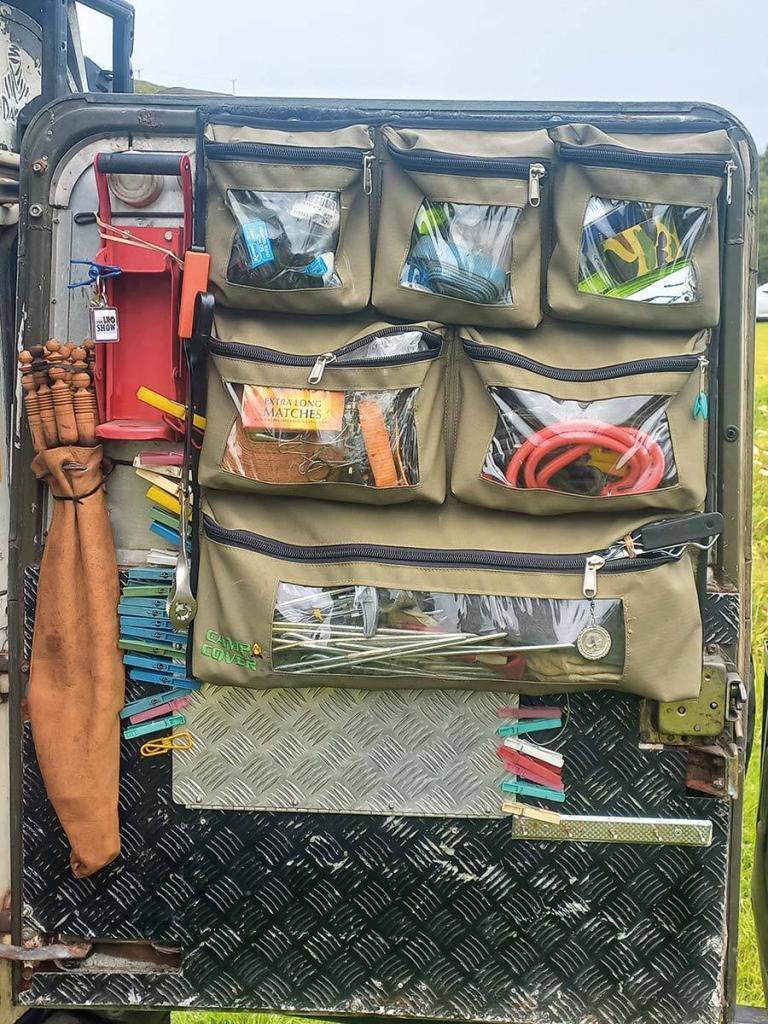

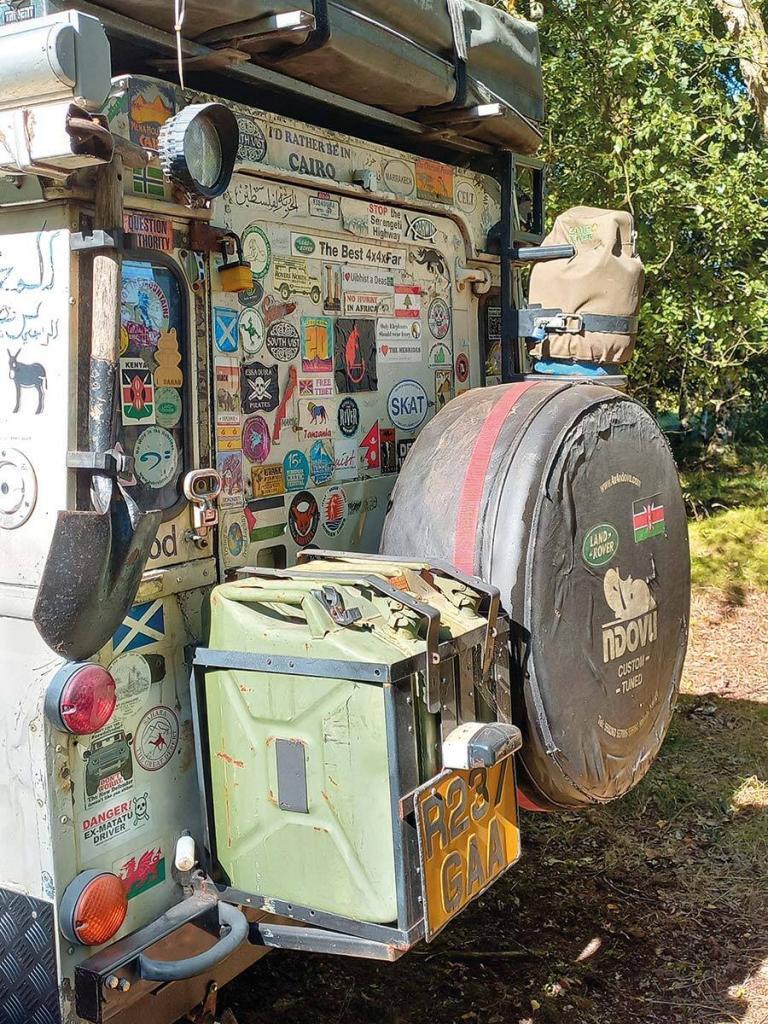
Over the 600,000+ kilometres of her life with me so far, she’s accumulated a few mascots—a silver St Christopher medallion from a village in France, a small pendant of Our Lady of Covadonga (a gift from an elderly lady in the Spanish village of that name), a fossil belemnite from Morocco and a big hank of lion hair from the Serengeti, an earring made from the cap of a bottle of Tusker lager from Kenya and a Tuareg ring from Niger—they all used to hang from her rear view mirror as a 110. They have reappeared now in the 130, along with the Corgi Land Rover 109” I used to play with when I was five, and dreamed of owning a car like this.
LIGHTS
Driving at night in the desert and in developing countries is never a good idea, but sometimes Murphy’s Law has an effect on planning and you are forced to do it. I wanted to make sure Elsa’s lights were up to the task, as her original 30-year-old headlamp reflectors and wiring were showing their age.
Initially, I considered LED lights for the main beam, but ensuring a vehicle with non-factory fit LED main beams is legal in the UK can often be problematic. So I abandoned that idea. I also considered LED lights for the sidelights, but when testing candidate light units I found their output to be very “directional” and narrow-beamed. Not ideal for safety. In the end, I stayed with standard bulbs and chose Osram Night Breaker headlamp units, augmented by LED light bars.
As a 110, Elsa had had large circular Wipac driving lights on her nose to work alongside her headlamps, but I felt these obstructed airflow to the radiator and intercooler, so I removed them and fitted a low-profile light bar on her nose, together with a larger curved light bar over the windscreen. To lessen glare and reflection from this, I painted her bonnet matt black—and, of course, the sun visor helped.
TEST RUN
In time all seemed good to go, and I planned a test trip. Time did not allow a trip outside the UK, so I plotted a route around northern England and the west coast of Scotland. This would enable a nice mix of fast, long-range highway driving, rough trail driving (where legally allowed), remote-area camping (again, where legal) using the vehicle as a base camp, and existence “off grid” and away from resupply for several days.
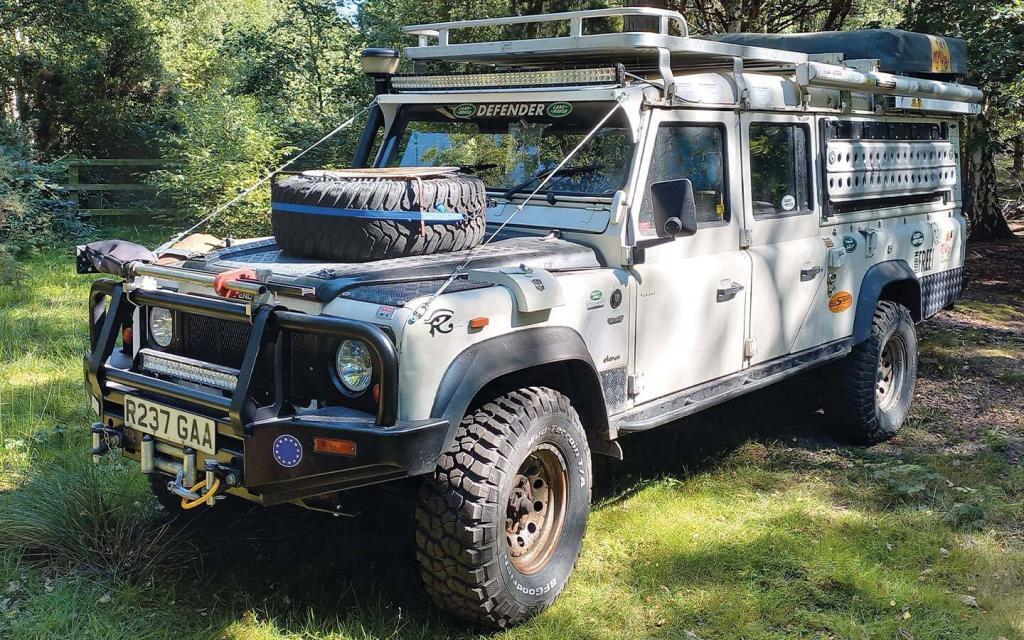
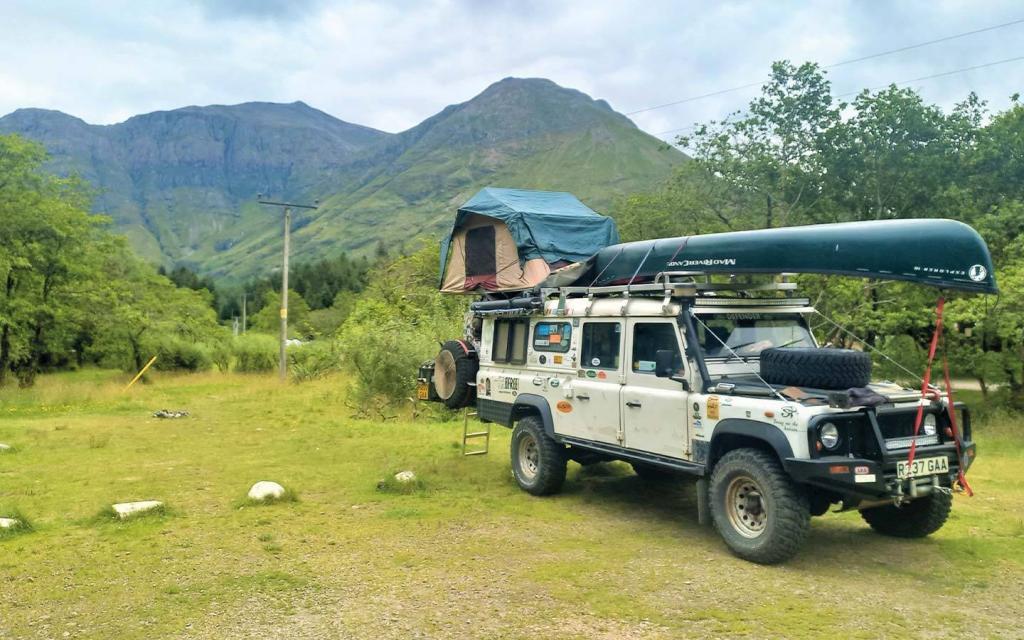
In the event, the engine swap and modifications proved very successful. Elsa can now cruise 20 km/h faster as a 130 than as a 110, with less noise and at a lower engine temperature. The extra size and weight do not contribute any extra instability. The roof tent and awnings (one on each side) work well, and the water tanks and kitchen arrangements are very pleasing to live with.
Access to the cargo space is great and the double-length gullwing makes setting up camp much easier. I didn’t anticipate the rear door being about 4 cm higher from the ground because of the increased length of the body and the slight nose-down attitude of the vehicle—this makes climbing up to pitch the roof tent more “interesting” than before, but it’s still acceptable. So, all in all, very pleased indeed with the “stretch.”
FINAL CONSIDERATIONS
Things aren’t finished yet. As a 110, she carried a long-range secondary fuel tank from a Gulf War-era SAS Desert Patrol Land Rover. We haven’t been able to fit this to her 130 configuration yet, because of an issue with locating the filler neck, but I’m determined that it will go in. I want to fit a capillary engine water temperature gauge to the 300Tdi block, but the port for the sensor is on the top of the block, and the weight of the 285 spare wheel flexes the bonnet so much that the sensor is damaged when bouncing about off-road—so ingenuity needed there.
Again, as a 110, she had a roof console which housed a CD player and CB radio. This has been replaced with a lighter, slimmer console in the 130, but the stereo now won’t fit…so more modifications are needed. The rear accommodation needs work—living in Arabia as I do, I’m having a set of traditional Bedouin “majlis” cushions made to fit the rear load bed. These will be able to be used as a double bed in the rear, or removed to be seating outside the truck in a camp setting.
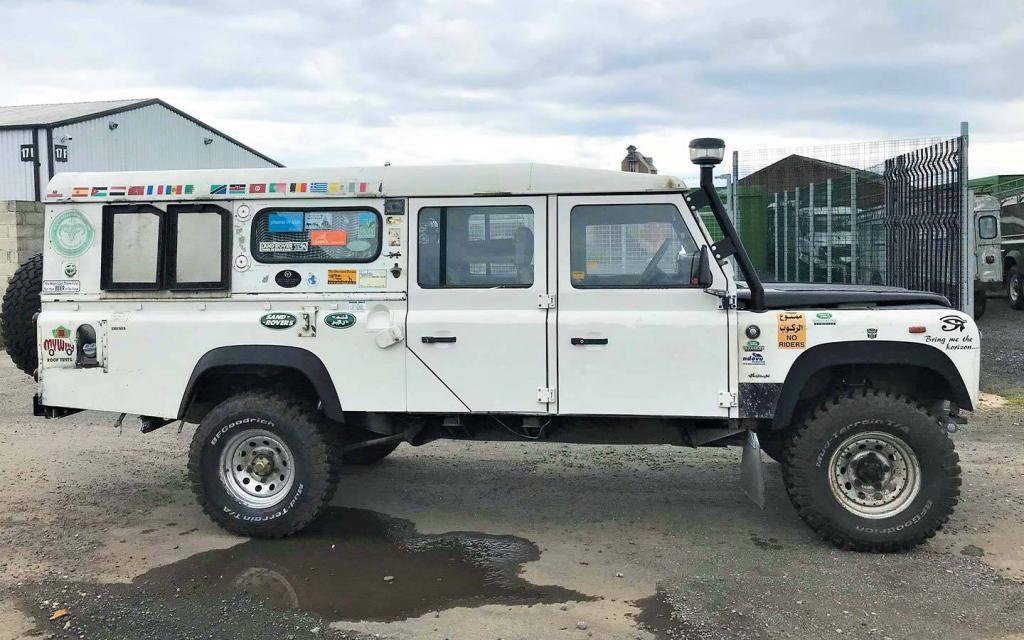
In the final analysis, the “stretch” has been a great success. Replacement of worn parts, addition of some handy ideas, like the wired-in and wing-mounted air compressor, extra living space and extra seating space—and all done at a sensible price. She’s ready for the next 600,000 km now!

